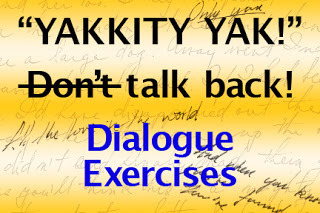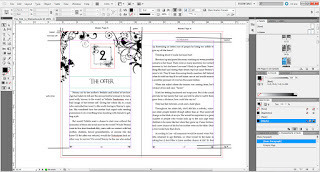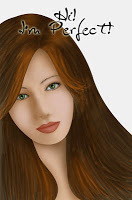Jo Michaels's Blog, page 96
April 29, 2013
Dialogue Exercises - #1
Happy Monday, good people of the blogosphere! This week we'll be delving into dialogue. I'll give you a total of fifteen exercises (three per day) you can do to make your dialogue stronger. Nothing ruins a great story quite like stilted dialogue, unnatural sounding dialogue, no dialogue at all, or overabundance of conversation. So, grab your pens and notebooks and let's get going!

There are so many different ways to use dialogue to improve story flow. These exercises will help you overcome some of the things that stilt a story. Again, this series is part of the writing class I give over on INDIE Books Gone Wild.
Every exercise below calls for at least two pages of dialogue.
Exercise 1: Using dialogue to reveal setting.
Take two characters you've used in a past novel and throw them into a scene together. Only using dialogue, reveal to the reader what setting the characters are in. I'm asking you to use two characters you've written before so you have an idea of the types of things they'll notice. You may want to throw in a conflict here and have them argue about where they are. As another option, perhaps it's a place neither have been before and they're exclaiming over things they see. Remember, be gradual. No information dumps. What would they say?
Exercise 2: Using dialogue to reveal or convey feelings.
Write a conflict scene between two characters you've written that love one another. Do it from one person's POV then switch. Betrayed to betrayer. Feel what they're feeling and use it.
Exercise 3: Weaving dialogue, action, and narrative together.
Using one of the reveal scenes from above, go back and add action to the scene. Put in little facial clues or gestures to show the reader more. Try adding a narrator to the scene. Where would they comment on what's going on? Now cut 1/4 of the dialogue and let the action be the revealing element. Read for flow.
There are a number of things you can use dialogue to do. Rather than giving your reader a couple of paragraphs about the setting, give them lines where the character reacts to what he/she is seeing. Avoid the information dump.
I hope you enjoyed this post and did at least one of the exercises. Come on back tomorrow for more!
Well, that's all for today, folks! Until next time, WRITE ON!
Jo

There are so many different ways to use dialogue to improve story flow. These exercises will help you overcome some of the things that stilt a story. Again, this series is part of the writing class I give over on INDIE Books Gone Wild.
Every exercise below calls for at least two pages of dialogue.
Exercise 1: Using dialogue to reveal setting.
Take two characters you've used in a past novel and throw them into a scene together. Only using dialogue, reveal to the reader what setting the characters are in. I'm asking you to use two characters you've written before so you have an idea of the types of things they'll notice. You may want to throw in a conflict here and have them argue about where they are. As another option, perhaps it's a place neither have been before and they're exclaiming over things they see. Remember, be gradual. No information dumps. What would they say?
Exercise 2: Using dialogue to reveal or convey feelings.
Write a conflict scene between two characters you've written that love one another. Do it from one person's POV then switch. Betrayed to betrayer. Feel what they're feeling and use it.
Exercise 3: Weaving dialogue, action, and narrative together.
Using one of the reveal scenes from above, go back and add action to the scene. Put in little facial clues or gestures to show the reader more. Try adding a narrator to the scene. Where would they comment on what's going on? Now cut 1/4 of the dialogue and let the action be the revealing element. Read for flow.
There are a number of things you can use dialogue to do. Rather than giving your reader a couple of paragraphs about the setting, give them lines where the character reacts to what he/she is seeing. Avoid the information dump.
I hope you enjoyed this post and did at least one of the exercises. Come on back tomorrow for more!
Well, that's all for today, folks! Until next time, WRITE ON!
Jo
Published on April 29, 2013 07:22
April 26, 2013
Healing Plot Wounds
Happy FRIDAY, good people of the blogosphere! What a week! Here comes the the weekend, though. I hope you all have wonderful plans. Today, we're gonna talk about some common plot wounds and how you can heal them. So, grab your pens and notebooks and let's get going!

Problem 1: Your flashback is all mucked up.
Make sure you need it. Remember, a flashback will disrupt the flow of the story and pull the reader into the past for some reveal. It should never be an information dump, but a high-energy scene. If you keep your flashbacks short, all the better. Try working the information into dialogue instead. That way, the story keeps moving forward, but your readers get the information you've deemed necessary.
Problem 2: Your scene has no two-punch.
You know that height of the scene where exciting things happen? Find it in your story and highlight it. See how much you can dump before it happens so there's less drag getting there. You'll likely find a lot of the wordy things before the action can be removed and it still work. Then, give it a two-punch. You know, that little something extra. Some emotion or reaction as the action occurs.
Problem 3: You're holding back your characters because they're off plot.
Suddenly, your characters are trying to go left but you force them to turn right. That wasn't what you had in mind and no-way no-how are you letting them go there. This will hinder your story. Try opening a new document and let the character go the way you think they would. Have a conversation, run a scene in your movie-projector mind, or type a quick scene out where your character faces something out of the ordinary. Don't force them to react a certain way. Let the character decide. Then, return to your story and let them play it out the way they want to. It works. As a bonus, the outcome might surprise you. I didn't intend the twist in The Bird, the characters did that on their own.
Problem 4: Mind-system shutdown.
Overload. Your mind shuts off, your imagination takes a break, or a head cloud invades. How do you turn it back on? Writers don't have switches on the side of their heads. If this happens, try one of these tricks: Act out a scene. Don't imagine it, get your booty out of your chair and act it out. Take a walk and have a conversation with your protagonist. No, I'm not kidding. Sometimes, this is just what you need to understand their vision and/or motive. Maybe those crazies on the street, walking along, mumbling to themselves, are actually writers trying to get back in touch, eh? Write down what your novel means to you. What's the underlying message?
These are just a few of the problems we all run in to. I hope the suggestions above help in some small way.
What do you do when problems smack you between the eyes?
Well, that's all for today, folks! Until next time, WRITE ON!
Jo

Problem 1: Your flashback is all mucked up.
Make sure you need it. Remember, a flashback will disrupt the flow of the story and pull the reader into the past for some reveal. It should never be an information dump, but a high-energy scene. If you keep your flashbacks short, all the better. Try working the information into dialogue instead. That way, the story keeps moving forward, but your readers get the information you've deemed necessary.
Problem 2: Your scene has no two-punch.
You know that height of the scene where exciting things happen? Find it in your story and highlight it. See how much you can dump before it happens so there's less drag getting there. You'll likely find a lot of the wordy things before the action can be removed and it still work. Then, give it a two-punch. You know, that little something extra. Some emotion or reaction as the action occurs.
Problem 3: You're holding back your characters because they're off plot.
Suddenly, your characters are trying to go left but you force them to turn right. That wasn't what you had in mind and no-way no-how are you letting them go there. This will hinder your story. Try opening a new document and let the character go the way you think they would. Have a conversation, run a scene in your movie-projector mind, or type a quick scene out where your character faces something out of the ordinary. Don't force them to react a certain way. Let the character decide. Then, return to your story and let them play it out the way they want to. It works. As a bonus, the outcome might surprise you. I didn't intend the twist in The Bird, the characters did that on their own.
Problem 4: Mind-system shutdown.
Overload. Your mind shuts off, your imagination takes a break, or a head cloud invades. How do you turn it back on? Writers don't have switches on the side of their heads. If this happens, try one of these tricks: Act out a scene. Don't imagine it, get your booty out of your chair and act it out. Take a walk and have a conversation with your protagonist. No, I'm not kidding. Sometimes, this is just what you need to understand their vision and/or motive. Maybe those crazies on the street, walking along, mumbling to themselves, are actually writers trying to get back in touch, eh? Write down what your novel means to you. What's the underlying message?
These are just a few of the problems we all run in to. I hope the suggestions above help in some small way.
What do you do when problems smack you between the eyes?
Well, that's all for today, folks! Until next time, WRITE ON!
Jo
Published on April 26, 2013 05:08
April 25, 2013
Slimming Down
Happy Thursday, good people of the blogosphere! I can't believe I missed my hump-day post, but working too much is never something I complain about. Today, we're talking about slimming down an overweight novel. These are just a few things you can do to cut out the drag. Remember, a good editor will tell you when it isn't working and give you suggestions on how to fix it. Grab your pens and notebooks and let's get going, shall we?

When you're writing a novel, you generally have three acts. The first is to introduce the doorway and the challenge/opposition. By the time you get to the third, you're ready to bring things to a head and give your novel an ending. What a lot of writers struggle with is the journey, the middle, the part where you are heading toward the end. Sometimes, it ends up with no excitement. On Tuesday, I gave you ways to add to your skinny tale. Now we're gonna talk about ways to slim it down if it's too heavy.
Cut out the boring. If you find the story lacking tension, take some of the scenes out. These can be reaction scenes, dialogue, or scenes lacking conflict. If your editor might lose interest, cut it down or cut it out.Take away a subplot. You can absorb a subplot into the main plot to strengthen it, or combine two subplots into one to make things more interesting for the reader.Kill someone off. That's right, kill them. Maybe they're stealing the spotlight from the main character or maybe you just decide their motives aren't for the purpose of good. As an alternative, you can combine two secondary characters and make them into one strong character.
If you craft act two well, you have the opening for a killer ending. You can put your protagonist through hell only to have them be rewarded for their struggles. Or, you can always have your protagonist fail. Some of those endings make a so-so book one that's remembered.
What exercises do you use to trim the fat?
Well, that's all for today, folks! Until next time, WRITE ON!
Jo

When you're writing a novel, you generally have three acts. The first is to introduce the doorway and the challenge/opposition. By the time you get to the third, you're ready to bring things to a head and give your novel an ending. What a lot of writers struggle with is the journey, the middle, the part where you are heading toward the end. Sometimes, it ends up with no excitement. On Tuesday, I gave you ways to add to your skinny tale. Now we're gonna talk about ways to slim it down if it's too heavy.
Cut out the boring. If you find the story lacking tension, take some of the scenes out. These can be reaction scenes, dialogue, or scenes lacking conflict. If your editor might lose interest, cut it down or cut it out.Take away a subplot. You can absorb a subplot into the main plot to strengthen it, or combine two subplots into one to make things more interesting for the reader.Kill someone off. That's right, kill them. Maybe they're stealing the spotlight from the main character or maybe you just decide their motives aren't for the purpose of good. As an alternative, you can combine two secondary characters and make them into one strong character.
If you craft act two well, you have the opening for a killer ending. You can put your protagonist through hell only to have them be rewarded for their struggles. Or, you can always have your protagonist fail. Some of those endings make a so-so book one that's remembered.
What exercises do you use to trim the fat?
Well, that's all for today, folks! Until next time, WRITE ON!
Jo
Published on April 25, 2013 05:10
April 23, 2013
Beating Middle of the Book Blahs
Happy Tuesday, good people of the blogosphere! Today we're talking about middle of the book blahs and how to overcome them. So grab your pens and notebooks and let's get going, shall we?

Again, this is another section of the class offered over on IBGW.
We've all been there. That point where the character is dragging along on their journey toward triumph or failure of their ultimate goal. It's the dreaded middle of the book. After the doorway and before the culmination and reveal of all that's interesting. But how do you overcome the blahs? How do you keep your story from plodding along like a draught horse rather than bringing excitement like the thoroughbreds running in the Kentucky Derby?
A few things you can do:
Add a subplot. This should be done rarely and with care. Your subplot can be brought to a head just before your main plot, but don't let it take over and don't do it too often. A well-known subplot for many readers is the one in the Hunger Games series. I know I reference it often, but it uses many literary devices (and does it well).Introduce a new character. From out of the wild, here they come, that new character you may have mentioned before but decides to take on a new role. Or, you may not have mentioned this character. Perhaps they only show up in the middle of the book to bring another facet to the action. They need to make the protagonist's life a little bit harder.Find the glue between the antagonist and the protagonist and make it stronger. Make it matter. Show the reader why these two are in direct opposition by a little reveal of the past.
Now, those are just a couple of suggestions. The options are endless because it's your imagination. Dig deeply and don't allow your reader to go to sleep.
Join me tomorrow and we'll go over how to trim the fat from the middle of a book.
What devices do you use to add drama to the middle of your novel?
On another note, if you'd like a new book to read, Taken Before her very Eyes by Wade Faubert, the one I reviewed back in February is free through midnight tonight! See the review here.
Get it on Amazon US.
Get it on Amazon UK.
Enjoy!
Well, that's all for today, folks! Until next time, WRITE ON!
Jo

Again, this is another section of the class offered over on IBGW.
We've all been there. That point where the character is dragging along on their journey toward triumph or failure of their ultimate goal. It's the dreaded middle of the book. After the doorway and before the culmination and reveal of all that's interesting. But how do you overcome the blahs? How do you keep your story from plodding along like a draught horse rather than bringing excitement like the thoroughbreds running in the Kentucky Derby?
A few things you can do:
Add a subplot. This should be done rarely and with care. Your subplot can be brought to a head just before your main plot, but don't let it take over and don't do it too often. A well-known subplot for many readers is the one in the Hunger Games series. I know I reference it often, but it uses many literary devices (and does it well).Introduce a new character. From out of the wild, here they come, that new character you may have mentioned before but decides to take on a new role. Or, you may not have mentioned this character. Perhaps they only show up in the middle of the book to bring another facet to the action. They need to make the protagonist's life a little bit harder.Find the glue between the antagonist and the protagonist and make it stronger. Make it matter. Show the reader why these two are in direct opposition by a little reveal of the past.
Now, those are just a couple of suggestions. The options are endless because it's your imagination. Dig deeply and don't allow your reader to go to sleep.
Join me tomorrow and we'll go over how to trim the fat from the middle of a book.
What devices do you use to add drama to the middle of your novel?
On another note, if you'd like a new book to read, Taken Before her very Eyes by Wade Faubert, the one I reviewed back in February is free through midnight tonight! See the review here.
Get it on Amazon US.
Get it on Amazon UK.
Enjoy!
Well, that's all for today, folks! Until next time, WRITE ON!
Jo
Published on April 23, 2013 06:54
April 22, 2013
How to Find an Idea
Happy Monday, good people of the blogosphere! Well, the weekend is behind us, and we're moving into one heck of a work week. Mine is really full of work coming at me from INDIE Books Gone Wild. Formatting for print is among the top of those to-dos for this week. What fun! But I'd like to take a moment today and talk with you all about creating that next great book. Where do you come up with an idea? Following are some great exercises you can do to get those creative juices flowing. So, grab your pens and notebooks and let's get going!

By the way, this is part of the class I give over on IBGW for writers. If you're interested, check out the page and then fill out the form. It's a ton of fun and you even get a set of books no writer should be without.
Exercises:
You've all heard me go on and on about writing a story based on what you're passionate about. Well, that's exercise one. You can look into the social opinions of others and form your own. This can lead to a great idea for a story. Look at The Hunger Games. What's she writing about, really? Government control of a people and breaking free from tyranny. You can see the author's strong opinions about this issue within the story. She probably thought about a world that could exist at some point and then went on to another exercise, asking what if.Exercise two is all about taking a known situation and asking what if. Read the paper, watch television, or observe people in action all around you and ask that question. Make a list and let it rest for a couple of days. When you return, you'll see it teeming with ideas.Listen to music. Hear the lyrics and think about what the singer is saying. Enter Sandman by Metallica could bring out a great novel, right? Write down some ideas about the situations in the songs. Just make sure your music is related to the genre you prefer to write.For the next one, create a character. Loosely base them on someone you know and then add a splash of yourself to them. After that, you can turn them any way you see fit. Sometimes, a dynamic and original character is all you need. Close your eyes and write down the particulars of the first person that pops into your head. Flesh them out. Give them a journey.Mind map. You remember when I talked about creating blog posts from a mind map? You start with one topic and branch things off from there. By the time you get to the fourth or fifth spoke, you'll have a ton of ideas.
And there's a few ways you can come up with story/plot ideas when you're stuck. I do a couple of these exercises about once a week. Because of that, I have a folder on my laptop with one or two chapters of some really cool ideas. Will all of them ever be published? I doubt it. But some of them will. Either way, my idea is there in word form and I can reference it at any time.
What exercises do you partake in?
Well, that's all for today, folks! Until next time, WRITE ON!
Jo

By the way, this is part of the class I give over on IBGW for writers. If you're interested, check out the page and then fill out the form. It's a ton of fun and you even get a set of books no writer should be without.
Exercises:
You've all heard me go on and on about writing a story based on what you're passionate about. Well, that's exercise one. You can look into the social opinions of others and form your own. This can lead to a great idea for a story. Look at The Hunger Games. What's she writing about, really? Government control of a people and breaking free from tyranny. You can see the author's strong opinions about this issue within the story. She probably thought about a world that could exist at some point and then went on to another exercise, asking what if.Exercise two is all about taking a known situation and asking what if. Read the paper, watch television, or observe people in action all around you and ask that question. Make a list and let it rest for a couple of days. When you return, you'll see it teeming with ideas.Listen to music. Hear the lyrics and think about what the singer is saying. Enter Sandman by Metallica could bring out a great novel, right? Write down some ideas about the situations in the songs. Just make sure your music is related to the genre you prefer to write.For the next one, create a character. Loosely base them on someone you know and then add a splash of yourself to them. After that, you can turn them any way you see fit. Sometimes, a dynamic and original character is all you need. Close your eyes and write down the particulars of the first person that pops into your head. Flesh them out. Give them a journey.Mind map. You remember when I talked about creating blog posts from a mind map? You start with one topic and branch things off from there. By the time you get to the fourth or fifth spoke, you'll have a ton of ideas.
And there's a few ways you can come up with story/plot ideas when you're stuck. I do a couple of these exercises about once a week. Because of that, I have a folder on my laptop with one or two chapters of some really cool ideas. Will all of them ever be published? I doubt it. But some of them will. Either way, my idea is there in word form and I can reference it at any time.
What exercises do you partake in?
Well, that's all for today, folks! Until next time, WRITE ON!
Jo
Published on April 22, 2013 06:36
April 19, 2013
Templates for Using MS Word to Format for Print
Happy Friday, good people of the blogosphere! Today, I'm going to share some news and give you a coupon! How awesome are coupons? If you're an Indie author and you've been struggling to make your book look more professional through self-publishing platforms like CreateSpace, you're in for a treat.
Not long ago, I did a post about MS Word vs Adobe InDesign. I went through a few of the good and bad things for using each. Now, you have some additional options for making your book look awesome with MS Word. I know I'm not far off when I say, many of us just can't afford programs like Adobe InDesign and most of us wouldn't know how to use it even if we could. With InDesign, you can create books that look like this:

Now, I'm not saying you'll ever be able to do that with MS Word. I just don't know if it's possible. What I am saying is that you can have an awesome printed book for little to no cost. Keep reading.
I'm a regular subscriber to The Book Designer blog. His name is Joel Friedlander and he does a lot for those of us in the self-publishing world. If you don't already subscribe, I suggest you do so ASAP. It's a wonderful resource for Indie authors. Okay, moving on.
What's the big news? I'm getting to that!
Joel has partnered up with Tracy Atkins, author of Aeternum Ray and partner over at Dyslexiana , to bring you MS Word templates you can use to make your book look awesome in print. Yeah, I know, it was a little difficult for me to believe as well; but take a look at this post where Joel announces the launch. Those look pretty awesome, huh?
If you hop on over to their website BookDesignTemplates.com, you'll even get to download a free copy of their Book Design Templates Roadmap. It walks you through how to use the templates you buy. If you want to skip all the hubbub, you can go right on in and look at some of the templates available by clicking here.
Prices start at $37 each. But, after you buy one, you can use it time and again.
What's all this about a coupon?
Well, Joel is offering a coupon code for 41% off any template you buy. Holy moly, right? That makes each template's price start at just $15.17!! You can read all about it in his post here.
Without further ado, I give you the code: book41
You can follow Joel on Twitter, too. He's @JFBookman
Happy shopping!
Well, that's all for today, folks! Until next time, WRITE ON!
Jo
Not long ago, I did a post about MS Word vs Adobe InDesign. I went through a few of the good and bad things for using each. Now, you have some additional options for making your book look awesome with MS Word. I know I'm not far off when I say, many of us just can't afford programs like Adobe InDesign and most of us wouldn't know how to use it even if we could. With InDesign, you can create books that look like this:

Now, I'm not saying you'll ever be able to do that with MS Word. I just don't know if it's possible. What I am saying is that you can have an awesome printed book for little to no cost. Keep reading.
I'm a regular subscriber to The Book Designer blog. His name is Joel Friedlander and he does a lot for those of us in the self-publishing world. If you don't already subscribe, I suggest you do so ASAP. It's a wonderful resource for Indie authors. Okay, moving on.
What's the big news? I'm getting to that!
Joel has partnered up with Tracy Atkins, author of Aeternum Ray and partner over at Dyslexiana , to bring you MS Word templates you can use to make your book look awesome in print. Yeah, I know, it was a little difficult for me to believe as well; but take a look at this post where Joel announces the launch. Those look pretty awesome, huh?
If you hop on over to their website BookDesignTemplates.com, you'll even get to download a free copy of their Book Design Templates Roadmap. It walks you through how to use the templates you buy. If you want to skip all the hubbub, you can go right on in and look at some of the templates available by clicking here.
Prices start at $37 each. But, after you buy one, you can use it time and again.
What's all this about a coupon?
Well, Joel is offering a coupon code for 41% off any template you buy. Holy moly, right? That makes each template's price start at just $15.17!! You can read all about it in his post here.
Without further ado, I give you the code: book41
You can follow Joel on Twitter, too. He's @JFBookman
Happy shopping!
Well, that's all for today, folks! Until next time, WRITE ON!
Jo
Published on April 19, 2013 05:16
April 17, 2013
10 Tips for Creating a Squidoo Lens
Happy Wednesday, good people of the blogosphere! Today, I'm gonna give you ten tips for creating a great Squidoo lens. If you remember, Tuesday is lens creation day on the Social Networking Schedule. But you don't just want to create a lens that sits there with no activity, right? So grab your pens and notebooks and let's get going!
First off, let me abide by their request on their Squidoo Logo page and say, "I am not affiliated with or endorsed by Squidoo LLC."

Not that I'm selling you anything, see, but they politely ask that you state this if you use their logo. On to the good stuff!!
They have their own lens making tips that can be found here: http://hq.squidoo.com/tips/
Jo's top ten tips for creating a Squidoo lens:
Be sure you're creating original content and that you have the rights to publish/share said content. If you don't, your lens will be locked and (eventually) deleted.Decide on a snappy title, give your lens a good number of tags, and flesh out the description well. Use photos to make your lens aesthetically pleasing. Make sure your images are related to your topic. You don't want a photo of flowers in a post about the apocalypse (unless they're dead, maybe).Give your readers plenty of sections to peruse by using the add module button on the right hand side of your lens.Pay attention to the progress bar on the top right hand side and be sure you're fleshing out your lens with enough content to get to 100%.When/if you recommend products on your lens, make sure they're relevant to your content.If there's a YouTube video out there related to your topic, add it.Know what you're creating before you begin to create.If your ultimate goal is to sell something to the reader, make sure you're easing them into the sale rather than shoving it in their faces.Above all else, have fun. Create something folks can't (or don't want to) look up elsewhere. Squidoo is all about discussion and creating a community full of information with your own POV. Be original and have original thoughts.A couple of my lenses:
Book Formatting
Using Flipboard to Manage Social Media
Things I Learned from My Editor
Have you used Squidoo yet? Why/why not?
Well, that's all for today, folks! Until next time, WRITE ON!
Jo
First off, let me abide by their request on their Squidoo Logo page and say, "I am not affiliated with or endorsed by Squidoo LLC."

Not that I'm selling you anything, see, but they politely ask that you state this if you use their logo. On to the good stuff!!
They have their own lens making tips that can be found here: http://hq.squidoo.com/tips/
Jo's top ten tips for creating a Squidoo lens:
Be sure you're creating original content and that you have the rights to publish/share said content. If you don't, your lens will be locked and (eventually) deleted.Decide on a snappy title, give your lens a good number of tags, and flesh out the description well. Use photos to make your lens aesthetically pleasing. Make sure your images are related to your topic. You don't want a photo of flowers in a post about the apocalypse (unless they're dead, maybe).Give your readers plenty of sections to peruse by using the add module button on the right hand side of your lens.Pay attention to the progress bar on the top right hand side and be sure you're fleshing out your lens with enough content to get to 100%.When/if you recommend products on your lens, make sure they're relevant to your content.If there's a YouTube video out there related to your topic, add it.Know what you're creating before you begin to create.If your ultimate goal is to sell something to the reader, make sure you're easing them into the sale rather than shoving it in their faces.Above all else, have fun. Create something folks can't (or don't want to) look up elsewhere. Squidoo is all about discussion and creating a community full of information with your own POV. Be original and have original thoughts.A couple of my lenses:
Book Formatting
Using Flipboard to Manage Social Media
Things I Learned from My Editor
Have you used Squidoo yet? Why/why not?
Well, that's all for today, folks! Until next time, WRITE ON!
Jo
Published on April 17, 2013 06:22
April 16, 2013
Jonathan Swift and The Bird
Happy Tuesday, good people of the blogosphere! Today, I'm going over a little something I used when writing
The Bird
: Writers of the past and their books. Most notably of the many tales I interweave is that of Gulliver's Travels, written by Jonathan Swift. Grab your pens and notebooks and let's get going!
First, some interesting facts about Jonathan Swift from Wikipedia:
Born: November 30, 1667 in Dublin, IrelandWriter of: Novels and PoetryOriginally published everything under various pen names.Became Dean of St. Patrick's Cathedral and was entombed there upon his death in 1745.He looked like this:
 Photo courtesy of Wikipedia.
Photo courtesy of Wikipedia.
Interesting...
Now, if you've read The Bird , you'll know my heroine, Stormy, visits the grave of Mr. Swift at St. Patrick's Cathedral where she finds some rather tiny people. When I considered her quest and the golden apple she needed to procure for the witch, I thought how lovely it would be if Stormy had to face some Lilliputians. Seeing as the author of Gulliver's Travels was from Ireland, it made sense in my head to morph the little boogers into the gold-hungry, top-hat-wearing, shillelagh-carrying meanies we know as leprechauns.
Elves get a makeover, too.
I took a number of fairy tales I love and selected elements from them to weave a new-age story. To add to the realism, I also used a number of locations around the world to place scenes in the book. Did you know there's actually a place in Pennsylvania called Ringing Rocks?
It's these things that one must use to bring the element of believability to a fantasy novel. A world, changed ever-so-slightly, that reeks of truth. This is what I mean when I say you should write from life.
If you create another world, you're still using elements of something you've read about or experienced. Try using them in new ways. Step out of the box for a moment and reconsider everything you've been told. Put a new twist on something you know. Writers have awesome imaginations. Give them a workout.
Last, but not least, remember to always have truthiness in your tales. Never be afraid to take that extra step or go that extra mile. Use that word or phrase you've been wanting to. Speak your mind. Indies rock because there's no one lording over them, telling them what they can and can't say.
Is there something you've used from experience or prior readings? How did it spin your novel?
Well, that's all for today, folks! Until next time, WRITE ON!
Jo
First, some interesting facts about Jonathan Swift from Wikipedia:
Born: November 30, 1667 in Dublin, IrelandWriter of: Novels and PoetryOriginally published everything under various pen names.Became Dean of St. Patrick's Cathedral and was entombed there upon his death in 1745.He looked like this:
 Photo courtesy of Wikipedia.
Photo courtesy of Wikipedia.Interesting...
Now, if you've read The Bird , you'll know my heroine, Stormy, visits the grave of Mr. Swift at St. Patrick's Cathedral where she finds some rather tiny people. When I considered her quest and the golden apple she needed to procure for the witch, I thought how lovely it would be if Stormy had to face some Lilliputians. Seeing as the author of Gulliver's Travels was from Ireland, it made sense in my head to morph the little boogers into the gold-hungry, top-hat-wearing, shillelagh-carrying meanies we know as leprechauns.
Elves get a makeover, too.
I took a number of fairy tales I love and selected elements from them to weave a new-age story. To add to the realism, I also used a number of locations around the world to place scenes in the book. Did you know there's actually a place in Pennsylvania called Ringing Rocks?
It's these things that one must use to bring the element of believability to a fantasy novel. A world, changed ever-so-slightly, that reeks of truth. This is what I mean when I say you should write from life.
If you create another world, you're still using elements of something you've read about or experienced. Try using them in new ways. Step out of the box for a moment and reconsider everything you've been told. Put a new twist on something you know. Writers have awesome imaginations. Give them a workout.
Last, but not least, remember to always have truthiness in your tales. Never be afraid to take that extra step or go that extra mile. Use that word or phrase you've been wanting to. Speak your mind. Indies rock because there's no one lording over them, telling them what they can and can't say.
Is there something you've used from experience or prior readings? How did it spin your novel?
Well, that's all for today, folks! Until next time, WRITE ON!
Jo
Published on April 16, 2013 07:00
April 15, 2013
Uncovered Books
Happy Monday, good people of the blogosphere! Today, I'd like to tell you about a cool new service for indie authors. Strap in and take a little journey with me.

This service is a place you can sell your books. It's called Uncovered Books. They're going to sell via iPad and iPhone first, but have plans to expand to other platforms soon. You can check out the FAQ on their website.
Why is this exciting news? Well, they're offering a 50% royalty payment on every sale made. That's right, fifty percent. And you can price your book any way you want except free.
They ask some strange questions about your novel but promise that when readers sign up, the ideal person will be guided to your book. Why not, right?
Their intended launch date is Spring of 2013. This is a chance for you to get in on the ground floor of something new. Seems exciting!
Caveats:
You need to have an epub file of your book to upload.They aren't taking non-fiction at this time.No payments until you reach $40 in sales.Payments, at this time, are only via paper check mailed to the address you specify.I think it's an awesome idea and I hope this company goes boom! and explodes with growth. You can help!
What are you waiting for? Go sign up!
Well, that's all for today, folks! Until next time, WRITE ON!
Jo

This service is a place you can sell your books. It's called Uncovered Books. They're going to sell via iPad and iPhone first, but have plans to expand to other platforms soon. You can check out the FAQ on their website.
Why is this exciting news? Well, they're offering a 50% royalty payment on every sale made. That's right, fifty percent. And you can price your book any way you want except free.
They ask some strange questions about your novel but promise that when readers sign up, the ideal person will be guided to your book. Why not, right?
Their intended launch date is Spring of 2013. This is a chance for you to get in on the ground floor of something new. Seems exciting!
Caveats:
You need to have an epub file of your book to upload.They aren't taking non-fiction at this time.No payments until you reach $40 in sales.Payments, at this time, are only via paper check mailed to the address you specify.I think it's an awesome idea and I hope this company goes boom! and explodes with growth. You can help!
What are you waiting for? Go sign up!
Well, that's all for today, folks! Until next time, WRITE ON!
Jo
Published on April 15, 2013 09:08
April 12, 2013
Is Your Character Sexy or Beautiful?
Happy Friday, good people of the blogosphere! Today, let's talk about sexy vs beautiful. There is a difference! You need to consider how your character is going to be portrayed to the world because each of these gives them different characteristics. So, grab your pens and notebooks and let's get going, shall we?
First, a couple of definitions:
Sexy: sex·y /ˈseksē/ Adjective 1. Sexually attractive or exciting. 2. Sexually aroused.
Beautiful: beau·ti·ful /ˈbyo͞otəfəl/ Adjective 1. Pleasing the senses or mind aesthetically. 2. Of a very high standard; excellent.
 As you can see, they have different meanings. One can be sexy and not beautiful; or, one can be beautiful and not sexy. As we interpret language, we often confuse the two or use them interchangeably. But your character can be one or the other, or both. It's a difficult decision sometimes. You want to avoid the 'I'm perfect in every way' character because they're boring.
As you can see, they have different meanings. One can be sexy and not beautiful; or, one can be beautiful and not sexy. As we interpret language, we often confuse the two or use them interchangeably. But your character can be one or the other, or both. It's a difficult decision sometimes. You want to avoid the 'I'm perfect in every way' character because they're boring.
Examples:
I read Pride and Prejudice and thought of Elizabeth as beautiful but not sexy. Her sister, Jane, was both. Why? Well, Elizabeth held herself well but put off an 'I'm better than you' vibe toward men. It wasn't sexually exciting but her face was pleasing to look upon and her mind could stimulate another of the same caliber. Jane, on the other hand, was pretty, carried herself well, and excited men in a bashful, shy way. She was mysterious, sexy, and beautiful.
When I read Beautiful Disaster, I saw Abby as sexy, but not beautiful, because she had confidence. Her looks, as described by the author, were middling to fair.
Think about yourself for a moment. Do you wear pretty undergarments to make yourself feel beautiful or so you look sexually attractive in the mirror? One thing I do, to make myself feel beautiful, is keep my toenails painted. Always. Even in the winter, if you see me without shoes, my toenails are cute. These are things you have to consider when building a character because it's part of who they are. It gives you opportunities for discovery throughout the book. Like fairy dust sprinkled in to make magic, details like these make your character feel more real to the reader and allows a connection to be formed.
What character have you developed that was one or the other? What did you use as discovery tools?
Well, that's all for today, folks! Until next time, WRITE ON!
Jo
First, a couple of definitions:
Sexy: sex·y /ˈseksē/ Adjective 1. Sexually attractive or exciting. 2. Sexually aroused.
Beautiful: beau·ti·ful /ˈbyo͞otəfəl/ Adjective 1. Pleasing the senses or mind aesthetically. 2. Of a very high standard; excellent.
 As you can see, they have different meanings. One can be sexy and not beautiful; or, one can be beautiful and not sexy. As we interpret language, we often confuse the two or use them interchangeably. But your character can be one or the other, or both. It's a difficult decision sometimes. You want to avoid the 'I'm perfect in every way' character because they're boring.
As you can see, they have different meanings. One can be sexy and not beautiful; or, one can be beautiful and not sexy. As we interpret language, we often confuse the two or use them interchangeably. But your character can be one or the other, or both. It's a difficult decision sometimes. You want to avoid the 'I'm perfect in every way' character because they're boring.Examples:
I read Pride and Prejudice and thought of Elizabeth as beautiful but not sexy. Her sister, Jane, was both. Why? Well, Elizabeth held herself well but put off an 'I'm better than you' vibe toward men. It wasn't sexually exciting but her face was pleasing to look upon and her mind could stimulate another of the same caliber. Jane, on the other hand, was pretty, carried herself well, and excited men in a bashful, shy way. She was mysterious, sexy, and beautiful.
When I read Beautiful Disaster, I saw Abby as sexy, but not beautiful, because she had confidence. Her looks, as described by the author, were middling to fair.
Think about yourself for a moment. Do you wear pretty undergarments to make yourself feel beautiful or so you look sexually attractive in the mirror? One thing I do, to make myself feel beautiful, is keep my toenails painted. Always. Even in the winter, if you see me without shoes, my toenails are cute. These are things you have to consider when building a character because it's part of who they are. It gives you opportunities for discovery throughout the book. Like fairy dust sprinkled in to make magic, details like these make your character feel more real to the reader and allows a connection to be formed.
What character have you developed that was one or the other? What did you use as discovery tools?
Well, that's all for today, folks! Until next time, WRITE ON!
Jo
Published on April 12, 2013 05:50



